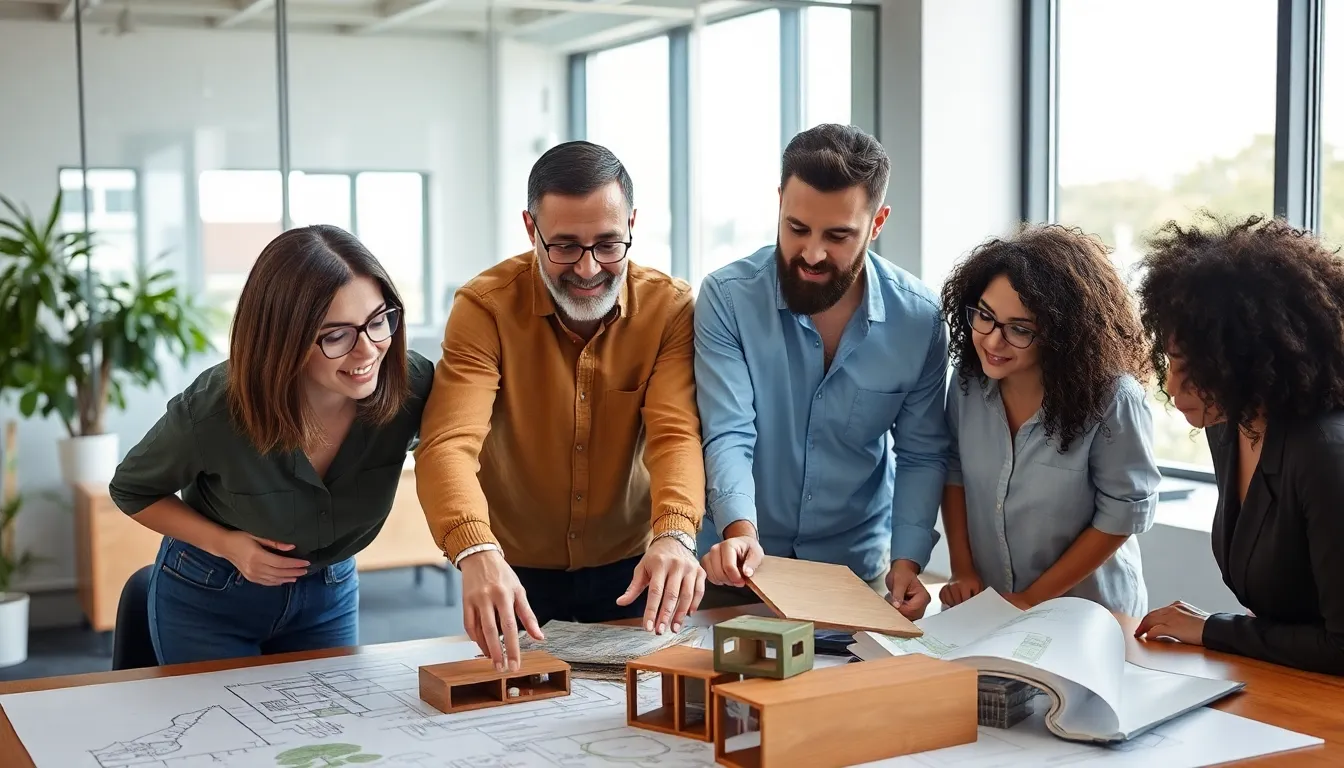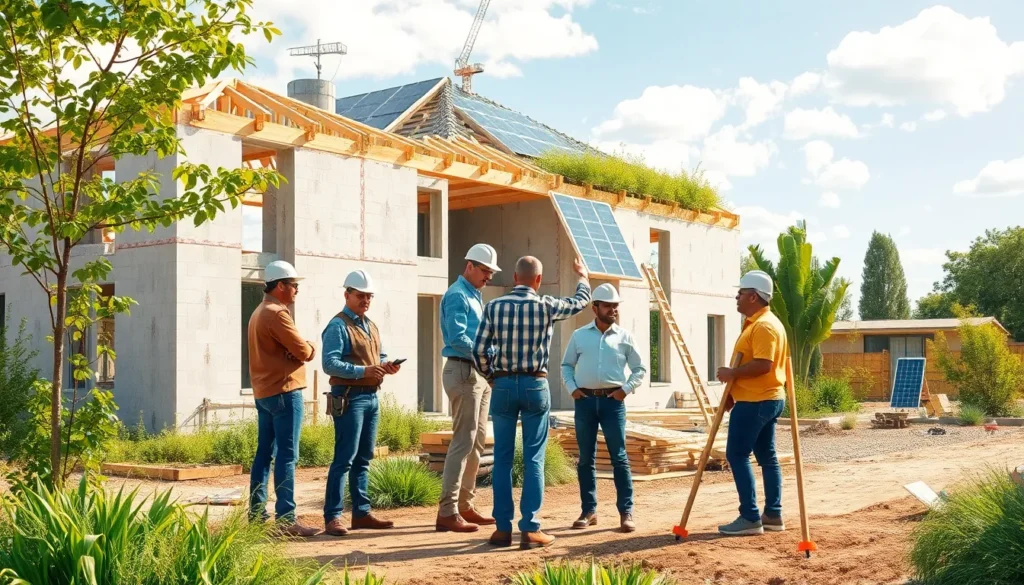Table of Contents
ToggleIn a world where climate change is the new buzzword and plastic straws are public enemy number one, sustainable building technology is stepping into the spotlight like a superhero in a green cape. Imagine constructing homes and offices that not only look good but also save the planet—now that’s a plot twist worth cheering for.
What Is Sustainable Building Technology?
Sustainable building technology encompasses innovative methods and materials that minimize environmental impact throughout a structure’s lifecycle. This technology focuses on energy efficiency, waste reduction, and resource conservation. Architects and builders increasingly incorporate these practices to create eco-friendly homes and offices.
Energy-efficient designs play a crucial role in sustainable building. Utilizing materials like insulated concrete forms and sustainable wood reduces energy consumption. Solar panels provide renewable energy, lowering utility costs while supporting the grid.
Water conservation techniques further enhance sustainability. Installing low-flow fixtures and rainwater harvesting systems aids in reducing water usage. Green roofs and permeable pavements promote stormwater management, improving urban resilience.
Sustainable building also emphasizes indoor environmental quality. Choosing non-toxic materials for finishes and furnishings contributes to healthier spaces. Effective ventilation systems prevent indoor air pollution, promoting well-being.
New technologies enhance sustainable practices. Smart home systems optimize energy use based on real-time data, allowing occupants to monitor consumption. Building information modeling (BIM) aids in efficient design and construction planning, reducing waste.
Government policies increasingly support sustainable building initiatives. Incentives for energy-efficient upgrades and sustainable practices create financial motivation for developers and homeowners. Certifications like LEED (Leadership in Energy and Environmental Design) encourage compliance with sustainable standards.
The integration of sustainable building technology addresses pressing ecological challenges. Each innovation contributes to reducing carbon footprints and combatting climate change. Sustainable buildings deliver not only aesthetic value but also a commitment to environmental stewardship.
Importance of Sustainable Building Technology

Sustainable building technology plays a crucial role in addressing climate change and promoting eco-friendly practices. Its integration into construction enhances both environmental and economic outcomes.
Environmental Benefits
Sustainable building technology reduces greenhouse gas emissions through energy-efficient designs and renewable resources. Utilizing materials like recycled steel and sustainably sourced wood lowers environmental impact. Water conservation practices, such as rainwater harvesting systems and xeriscaping, promote responsible water usage. Green roofs support biodiversity while decreasing urban heat islands. In addition, improved indoor air quality from non-toxic materials contributes to the health of occupants. Enhanced energy performance minimizes reliance on non-renewable energy sources. Overall, these practices lead to a significant reduction in environmental degradation.
Economic Advantages
Investing in sustainable building technology yields long-term cost savings through reduced energy and water bills. Structures designed with energy efficiency can experience up to 30% lower utility costs. Incentives and rebates from government programs can offset initial investment expenses. Furthermore, the durability of sustainable materials often results in lower maintenance costs. Increased property value arises from the growing demand for eco-friendly features among buyers. Sustainable buildings attract grants and financial support for being environmentally responsible. These economic benefits underscore the value of investing in sustainable building practices.
Key Components of Sustainable Building Technology
Sustainable building technology includes several key components that significantly enhance eco-friendliness in construction.
Renewable Energy Sources
Solar panels rank as the most popular renewable energy source, providing clean electricity. Wind turbines also contribute, generating energy for larger projects. Geothermal systems capture heat from the earth, offering an efficient heating and cooling solution. By integrating these technologies, buildings decrease reliance on fossil fuels, which reduces greenhouse gas emissions. Energy storage systems, like batteries, ensure that generated energy is available when needed, promoting consistent energy supply. Together, these renewable solutions make a substantial impact on overall energy efficiency.
Efficient Water Management
Water conservation techniques play an essential role in sustainable building design. Low-flow fixtures, such as faucets and toilets, significantly reduce water usage. Rainwater harvesting systems collect rainwater from roofs, allowing its use for irrigation and non-potable needs. Greywater recycling systems treat and reuse water from sinks and showers, further minimizing waste. By implementing these strategies, buildings reduce their water footprint and contribute to responsible water management. Effective landscape design using native plants also enhances water efficiency by requiring less irrigation.
Sustainable Materials
Sustainable materials are crucial in reducing the environmental impact of construction. Recycled materials, such as reclaimed wood and aluminum, offer alternatives that minimize new resource extraction. Bamboo stands out for its rapid growth and strength, making it a sustainable choice. Additionally, materials with low embodied energy, including insulated concrete forms, contribute to overall energy efficiency. Non-toxic finishes and adhesives improve indoor air quality, benefiting occupant health. Prioritizing these materials helps ensure that buildings support sustainability goals while enhancing aesthetic appeal.
Examples of Sustainable Building Technology
Sustainable building technology incorporates various innovative solutions that enhance eco-friendliness in construction. Two prominent examples include green roofs and smart home technologies.
Green Roofs and Living Walls
Green roofs consist of vegetation planted over a waterproofing membrane. These living features improve insulation, reduce heat buildup, and manage stormwater effectively. They also enhance urban biodiversity by providing habitats for birds and insects. Additionally, living walls offer similar benefits while making vertical spaces aesthetically pleasing. Multiple studies show that green roofs can decrease energy use by up to 15% annually. This significant reduction leads to lower utility costs, making green roofs an attractive choice for eco-conscious builders.
Smart Home Technologies
Smart home technologies transform the way buildings manage energy. Automated systems control lighting, heating, and cooling, ensuring optimal energy efficiency. They can adjust based on occupancy and user preferences, reducing waste significantly. Many devices integrate with renewable energy sources, such as solar panels, to further decrease reliance on nonrenewable resources. The implementation of smart meters allows homeowners to monitor real-time energy usage, facilitating informed decisions about consumption. Such technologies enhance convenience while promoting a sustainable lifestyle.
Challenges in Implementing Sustainable Building Technology
Implementing sustainable building technology presents several challenges. High initial costs often deter developers from pursuing eco-friendly projects. Budget constraints can limit the availability of advanced materials and innovative technologies that enhance sustainability.
Regulatory hurdles also complicate the adoption of these technologies. Local building codes may not align with sustainable practices, creating barriers that frustrate architects and builders. Achieving compliance while integrating green features can prove difficult.
Skilled labor shortages add another layer of complexity. Many construction workers lack the training to implement sustainable methods effectively. This gap in expertise can slow down project timelines and compromise quality.
Market demand for sustainable buildings can vary significantly. Despite growing awareness, some consumers may prioritize traditional construction due to perceived risk and higher costs. Educating potential buyers about the long-term benefits of sustainability remains crucial.
Competition within the industry can lead to inertia. Established construction practices may dominate over innovative approaches, hindering widespread acceptance of green technologies. Convincing stakeholders to embrace change requires significant effort.
Finally, reliance on new technologies can pose challenges. As with any emerging field, sustainable technologies can present reliability concerns. Builders must carefully assess their effectiveness and robustness during the project planning phase.
Addressing these challenges involves collaboration amongst stakeholders. Policymakers, architects, and builders must work together to create incentives and pathways for adopting sustainable building practices. When these barriers are overcome, the advantages of sustainability can be fully realized in the construction industry.
Sustainable building technology stands as a beacon of hope in the fight against climate change. By embracing innovative practices and materials, the construction industry can create spaces that not only meet aesthetic and functional needs but also prioritize environmental health.
The shift towards energy efficiency and resource conservation is not just a trend; it’s a necessary evolution. With the integration of renewable energy sources and smart technologies, buildings can significantly reduce their ecological footprints while promoting healthier living environments.
As the demand for eco-friendly construction continues to grow, collaboration among all stakeholders will be essential in overcoming challenges. The future of building lies in sustainability, making it a vital consideration for architects, builders, and homeowners alike.







